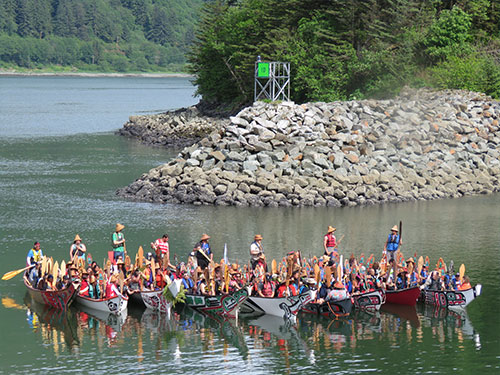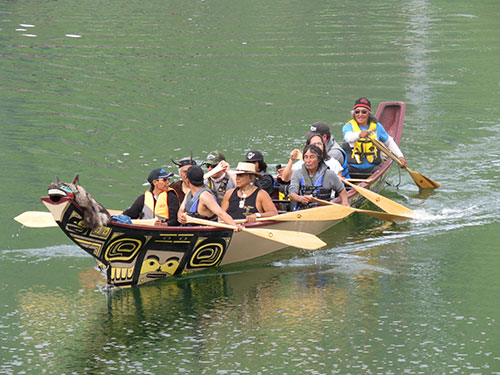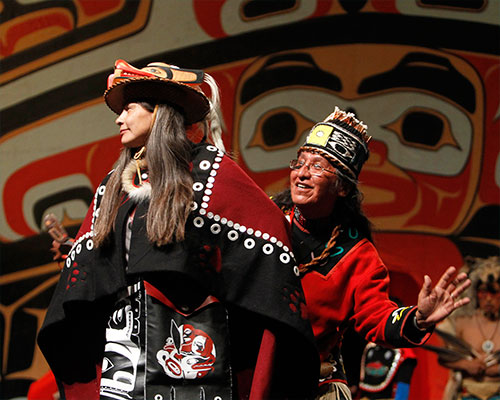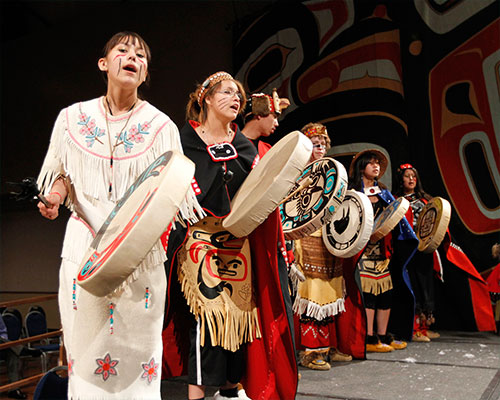
The Salmon StateA downriver homecomingBy MARY CATHARINE MARTIN
June 09, 2018
The trip, said Taku River Tlingit First Nation master carver Yaan Dekin Yeíl (Flying Raven) Wayne Carlick, a Raven of the Xooxhitan House who grew up on the Taku River, is “the first part of revitalizing this part of our culture.”
“That’s where we came from,” he said. “Juneau. Douglas, Alaska. Our people originated from there. We had some land that was given from trade through a potlatch… they gave some land inland here, and that’s how we ended up moving inland…. They put the border there, and suddenly we weren’t able to go back and forth.” On the Alaska side of the border, this year’s Celebration is also host to the beginning of another kind of healing for Douglas Indian Association Vice President John Morris Sr.: Wednesday, before Celebration officially began, they raised a healing totem pole commemorating the 1962 burning of the Yanyeidi Douglas Indian Village, which stood where Douglas Harbor now is. The Taku Kwáan dancers are invited to dance at the event, he said. Though they’ve never met and they come from two different sides of a border, the Taku River is an integral part of both Carlick and Morris’ lives. As a child, “I knew no other place besides the Taku River and Douglas Indian Village,” Morris said. “That was my world. I used to brag that you could blindfold me and put me on that river and in an hour I could tell you where I was from the breeze going through the trees and the fragrance of the cranberries.”
Homecoming After he left the Taku, in his twenties, Carlick returned to the Taku to build a cabin there. “I used to think about how our people used to get up their river,” he said. He’d seen old, archived photos of people sailing upriver, but it wasn’t until he experienced some strong winds when he was building a cabin that it clicked. “It starting snapping the tops of the tall cottonwood trees off,” he said. “That’s when I realized, the wind, the powerful wind - would take them.” Carlick spent most of his career in Vancouver and has carved at the Smithsonian Museum and other locations as well, but in 2006, he returned to Atlin. It was the possibility of carving totems and a canoe with kids in Atlin that clinched his decision to return.
Nineteen people made the journey by river, Carlick said, seven of them from the Taku Kwáan dancers. They started their paddle about 50 miles from Juneau. Carlick’s “real dream” - though it might, he said, be more a dream for his children and grandchildren - is walking from Atlin to the Nakina River. From there, they’d board their canoes and float down the Nakina River to the Taku, then down the Taku to Juneau. “For myself, and (my) community, I think this canoe journey is very big step towards us finding our way again, as Tlingit people. Relationship building between the coastal and inland communities is a goal for many I think, and this trip will be the first of many I hope, that helps connect us as Tlingit people of the Taku,” wrote Geohaadoostée Shauna Yeoman-Lindstrom, one of the Taku Kwáan dancers who traveled another way.
“I think for indigenous people, we are (in) a time of transition — we are reconnecting with our cultures and weaving our teachings and values into our modern day way of life. Being able to use Haa Kusteeyí (our way of life in Lingít, the Tlingit language) is a tool, and it helps ground and bring balance into our lives and communities.” Carlick said the trip would be “an incredible journey going through some of the most pristine wilderness sights in North America, I think… past glaciers and everything else. … It’s only the beginning (of) reconnecting with our culture, our people in Juneau.”
Representations of fact and opinions in comments posted are solely those of the individual posters and do not represent the opinions of Sitnews.
|
|||||||



